Userpilot vs Usetiful: Which is Best for Your SaaS?
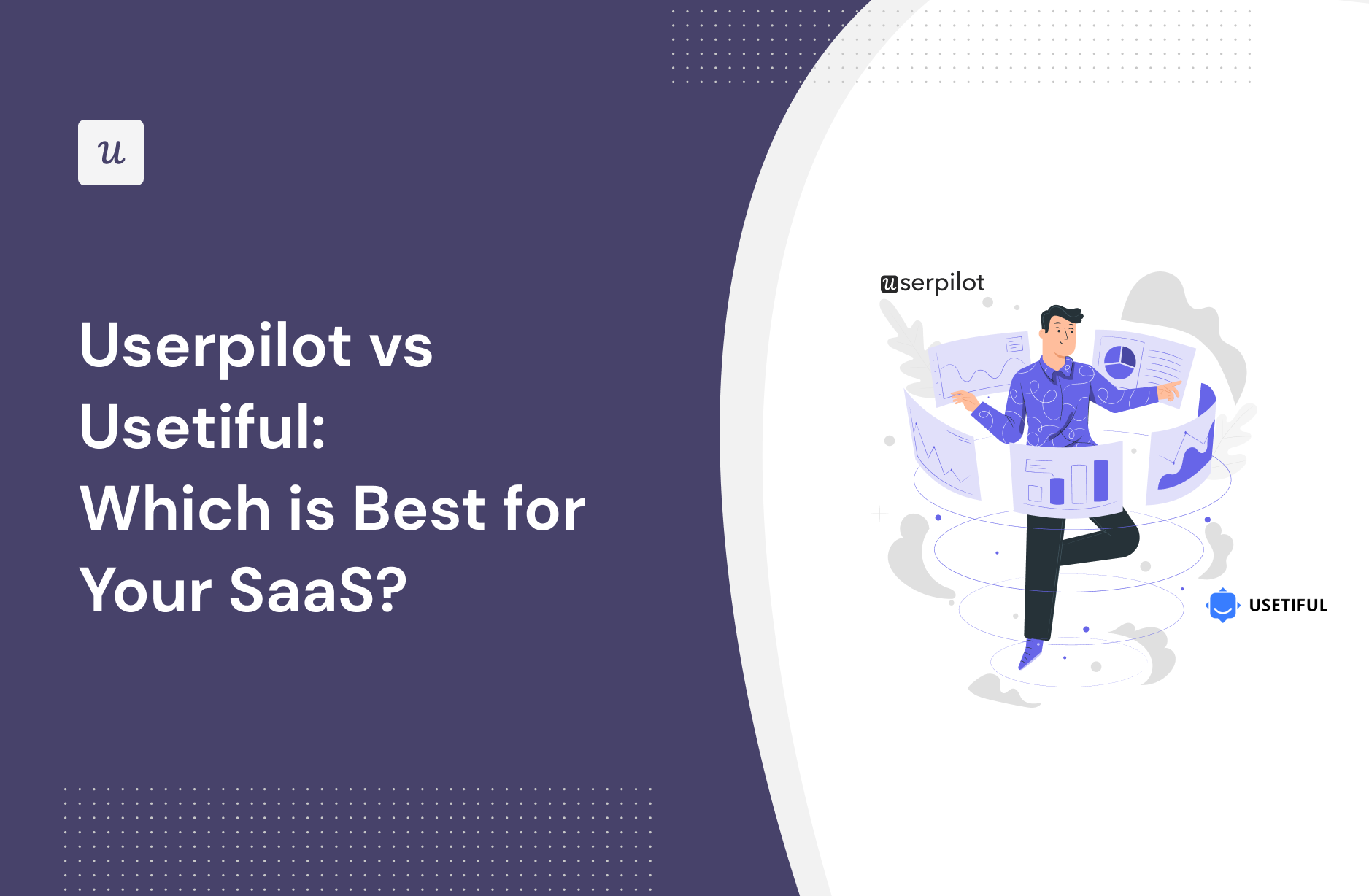
Wondering whether Userpilot or Usetiful is the best option for your SaaS company?
This article is going to dive into the Userpilot vs Usetiful debate and try to answer a key question: Which is the better tool for user onboarding, as well as other use cases?
In the post below, we’ve covered all the common use cases and done an in-depth analysis of the key features of Userpilot and Usetiful – as well as explaining which one is better in certain cases.
Let’s get into it!
TL;DR
- Let’s explore how Userpilot, and Usetiful compare when it comes to user onboarding and other common use cases.
- Userpilot is a product growth platform that drives user activation, feature adoption, and expansion revenue. It also helps product teams collect user feedback, streamline onboarding, and gather actionable insights from analytics.
- Usetiful is a no-code digital adoption platform that lets you build a layer of in-app experiences on top of any product. You can use it to delight new users with a seamless onboarding experience and improved self-service support. You can also run in-app surveys and collect customer feedback. It works particularly well for single-page applications.
- However, in certain situations, Usetiful offers several helpful features, such as product tours, tooltips, onboarding checklists, and banners. However, there are a few areas where Userpilot stands out. These include:
- Advanced user segmentation: Userpilot lets you segment users based on a wide array of attributes, behavior patterns, demographics, and custom events. You can even group users based on their responses to in-app surveys. Usetiful’s user segmentation parameters pale in comparison.
- In-depth user analytics: With Userpilot, you get a detailed glimpse into how users move through your app, interact with on-page elements, and use different features. These insights play a crucial role in improving product adoption and user retention. On the other hand, Usetiful only offers basic analytics, such as how many users started and completed an in-app experience.
- More survey options: Userpilot lets you choose from a broad spectrum of built-in survey templates, including NPS, CSAT, CES, and microsurveys. You can even build surveys from scratch and use advanced branching logic to tailor the flow of questions according to a user’s response. Usetiful lacks such variety in survey options.
- Robust integrations: Unlike Usetiful, Userpilot is compatible with a wide range of commonly used tools, such as Google Analytics, HubSpot, Amplitude, Heap, and Segment.
- Excellent customization: Userpilot’s built-in customization options are more extensive than Usetiful’s. You can modify the visual appearance, position, and other aspects of various UI patterns without getting caught up in the complexities of CSS.
- Get a Userpilot demo for user onboarding and drive your product growth code-free.
![]()
Userpilot – A Better Alternative for Your SaaS

What is Userpilot?
Userpilot is a product growth platform that drives user activation, feature adoption, and expansion revenue. It also helps product teams collect user feedback, streamline onboarding, and gather actionable insights from analytics.

With Userpilot, you’ll be able to track both product usage and user behavior to get a holistic view of how customers use your product — which will guide future development, improve the user experience, and inform your growth efforts.
What is Usetiful?
Usetiful is a no-code digital adoption platform that lets you build a layer of in-app experiences on top of any product. You can use it to delight new users with a seamless onboarding experience and improved self-service support. You can also run in-app surveys and collect customer feedback. It works particularly well for single-page applications.
Usetiful offers a WYSIWYG editor that lets you create product tours, onboarding checklists, in-app announcements, and more. You can even build an in-app resource center. These features come in handy for marketing, product, and sales teams alike. Moreover, Usetiful works on third-party products, making it suitable for employee onboarding as well.

Userpilot vs Usetiful for user onboarding
In this section of the article, we’re really going to compare Userpilot vs Usetiful in terms of user onboarding. That way, we’ll be able to figure out which tool – Userpilot or Usetiful – is the best option depending on your use case.
Userpilot for user onboarding
User onboarding is a crucial part of the customer journey as it speeds up the adoption process and increases retention rates. Onboarding is one of Userpilot’s core use cases along with product growth analytics and user feedback, so it has plenty of features that you can utilize.
Here are some Userpilot features you can use when onboarding new users:
- No-code builder: Creating flows with Userpilot is as simple as installing the Chrome extension, selecting the UI patterns you’d like to use, and then editing the content/settings to suit your use case. You can also use templates to create modals, slideouts, tooltips, and driven actions.

- Native tooltips: Userpilot lets you create native tooltips that show up when users hover over an element or click on an information badge. Since these native tooltips attach to the element itself, they aren’t page-dependent and will show up on any screen where that element is visible.

- Funnel analytics: Userpilot’s advanced analytics lets you create funnel reports that track the onboarding journey. You can also add filters (like name, user ID, signup date, operating system, country, etc.) and monitor the total conversion rate from the first step of the funnel to the last.
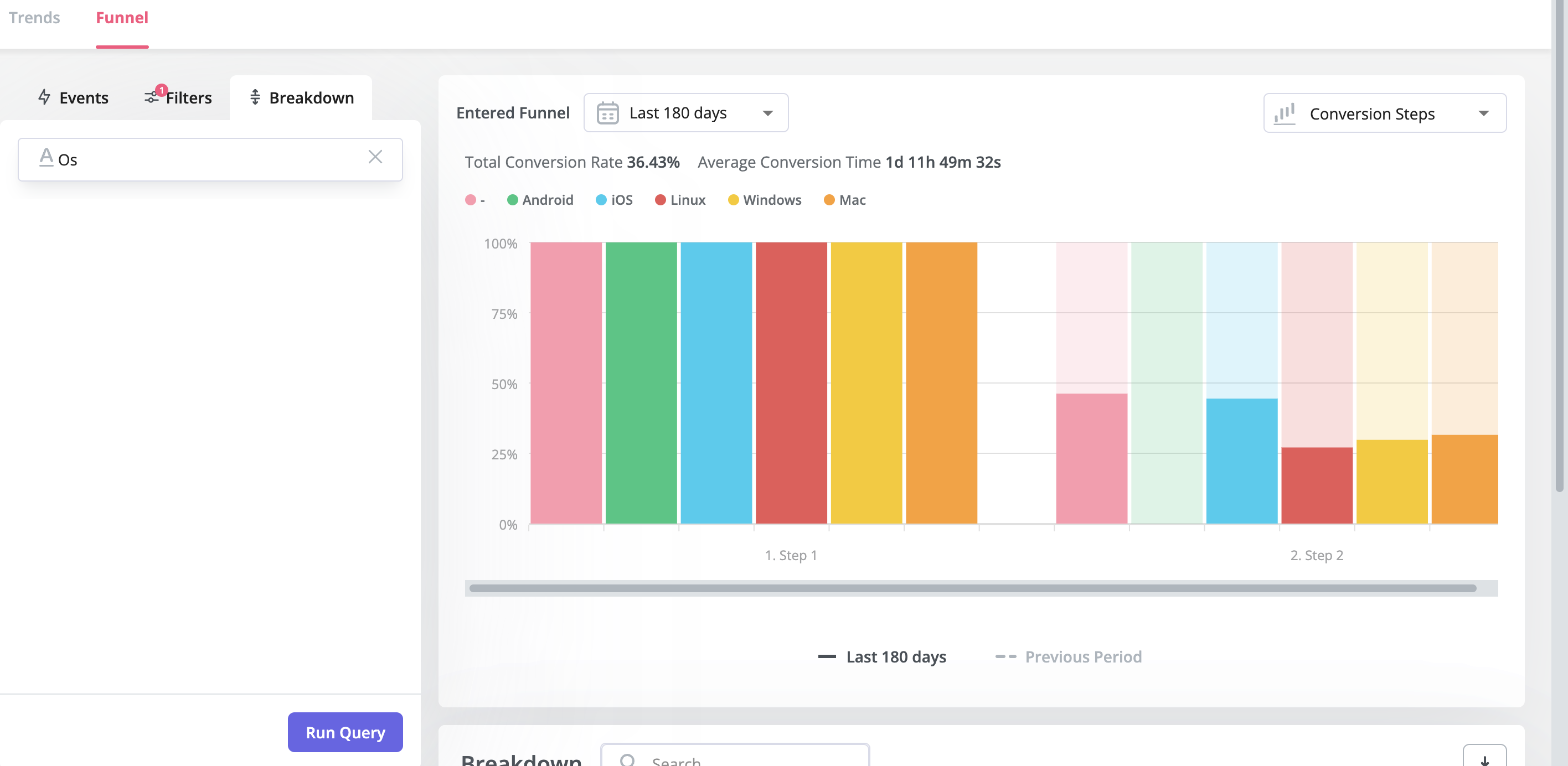
- User segmentation: Userpilot lets you segment users based on the device they’re using, where they’re located, their engagement data, or which NPS rating they selected on the latest survey. You can then filter your analytics dashboards to see which segments struggle with onboarding.

Usetiful for user onboarding
An intuitive and frictionless user onboarding experience can go a long way to impress new users and win their loyalty. It can also help improve feature adoption and drive product growth.
Usetiful offers several features to help you level up your user onboarding process. These include:
- The Tours feature lets you design interactive product tours and walkthroughs to provide step-by-step guidance. It comes in handy for providing new users with an overview of your product. You can also use it to walk them through key features.
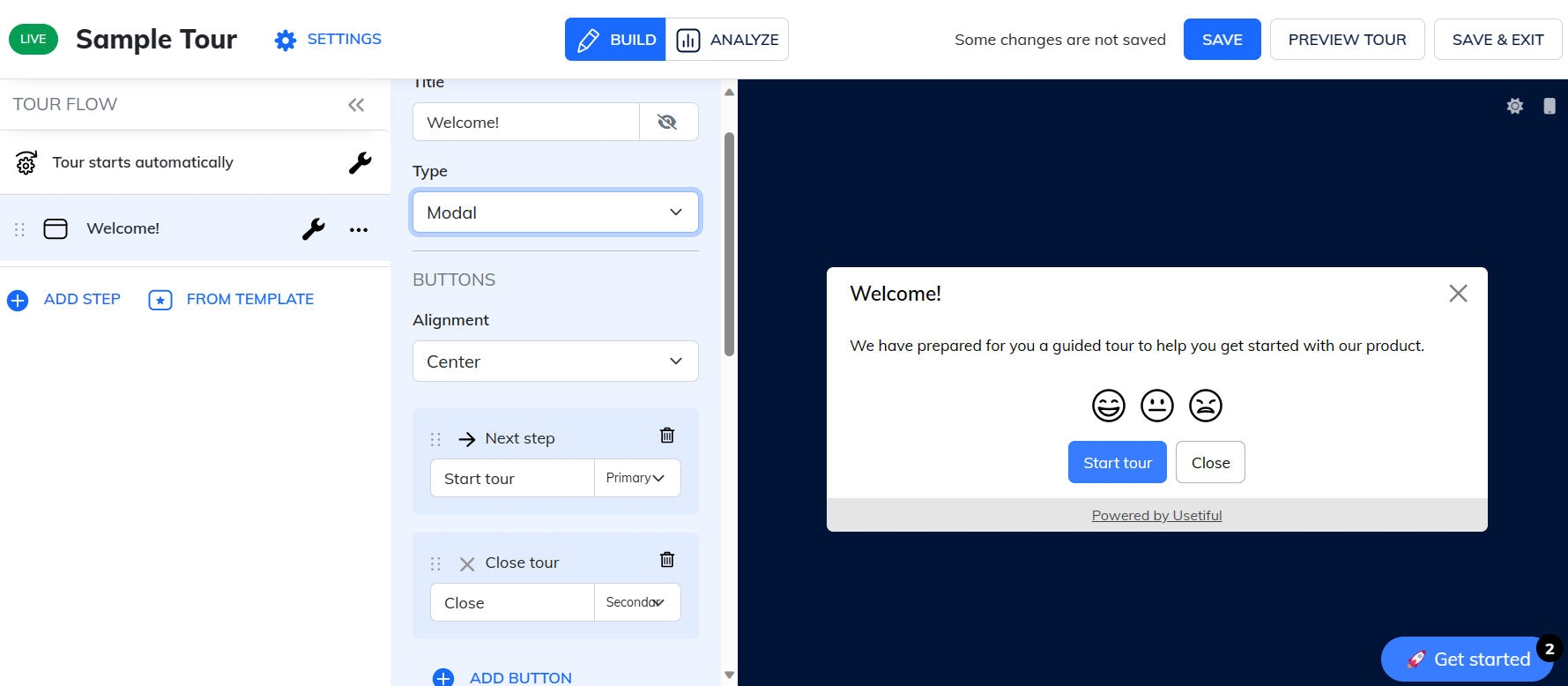
- You can build Tours using different UI elements, such as modals, sliders, and pointers. It’s also possible to add surveys to strategic points in a tour to collect feedback.
- The Smart Tips feature lets you create tooltips to provide users with always-available contextual guidance. You can use Smart Tips to help users navigate different on-page elements. Also, you can create a series of tips to minimize friction in the user experience.

- The Checklists feature lets you create helpful onboarding checklists. You can use it to guide new users through the setup process after signing up for your product. You can include various Tours or redirect users to specific pages. As a user completes each step, they can monitor their progress, and complete the onboarding journey.

- The Banners feature comes in handy for creating in-app notifications. You also have the option to create knowledge base articles and add them to the Knowledge Base Portal. Alternatively, you can set up the Assistants widget to create an in-app help center. It can eliminate points of friction in the user journey.
Userpilot vs Usetiful for product adoption
In this section of the article, we’re really going to compare Userpilot vs Usetiful in terms of product adoption. That way, we’ll be able to figure out which tool – Userpilot or Usetiful – is the best option depending on your use case.
Userpilot for product adoption
Product adoption is when users become repeat users of your product. It covers the entire journey spanning from the awareness stage to trial signup and finally full-on adoption. As a product growth platform, Userpilot has advanced analytics capabilities for tracking adoption over time.
Here are the Userpilot features that can help you measure and improve product adoption:
- Product analytics: Userpilot lets you create trend reports to track adoption over time by feature or segment, funnel reports that show you which steps of the process most users get stuck on, and integrations with third-party analytics providers so you can sync data between tools.
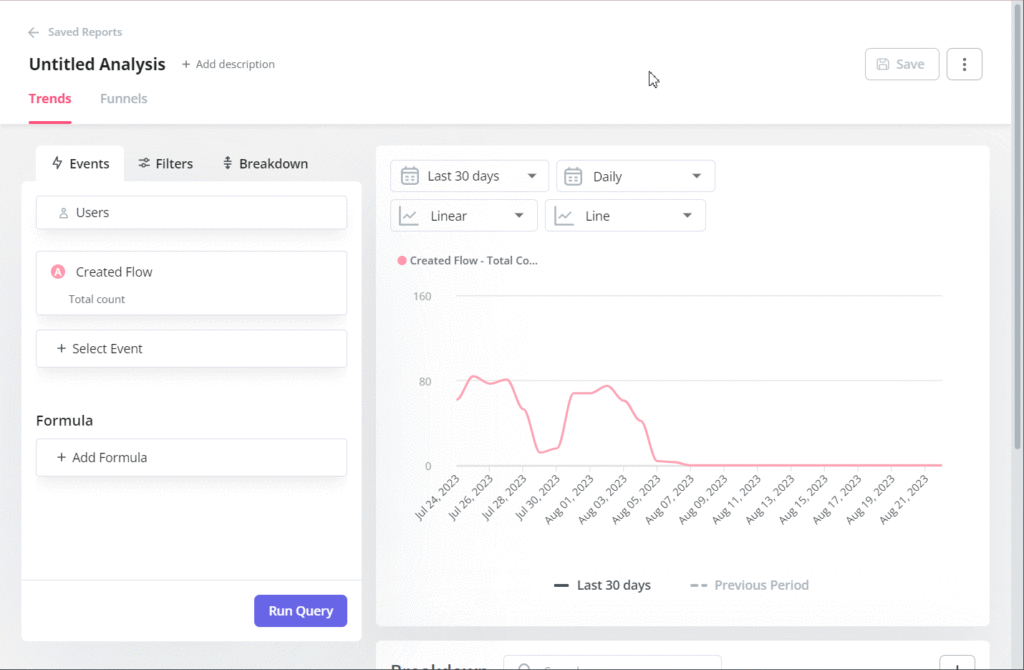
- Product usage dashboard: It collects all your key product usage metrics automatically without you having to set anything up: your Daily, Monthly, and Weekly Active Users and Companies, Trends of Active Users and Companies over time, user stickiness, top pages, features, and events, as well as the most engaged users, highest user activity times throughout the day, user retention, average session duration and product usage by browser.

- Feature engagement: Userpilot’s click-to-track feature tagger lets you see how often a feature is used and by how many people. You’ll also be able to see the top 20 events for a certain time period or create custom events that group multiple features together for clearer insights.

- Feedback collection: Userpilot has a no-code survey builder with 14 templates to choose from. You’ll be able to collect quantitative data like CSAT, CES, or NPS ratings and qualitative feedback on the strongest/weakest parts of your product straight from your users.

- User insights: The Insights dashboard lets you monitor user activity based on which segment they’re in and which company they’re from. You’ll also be able to choose from daily, weekly, and monthly time periods to see if user activity is shifting towards full product adoption over time.

Usetiful for product adoption
An intuitive and frictionless user onboarding experience can go a long way to impress new users and win their loyalty. It can also help improve feature adoption and drive product growth.
Usetiful offers several features to help you level up your user onboarding process. These include:
- The Tours feature lets you design interactive product tours and walkthroughs to provide step-by-step guidance. It comes in handy for providing new users with an overview of your product. You can also use it to walk them through key features.

- You can build Tours using different UI elements, such as modals, sliders, and pointers. It’s also possible to add surveys to strategic points in a tour to collect feedback.
- The Smart Tips feature lets you create tooltips to provide users with always-available contextual guidance. You can use Smart Tips to help users navigate different on-page elements. Also, you can create a series of tips to minimize friction in the user experience.

- The Checklists feature lets you create helpful onboarding checklists. You can use it to guide new users through the setup process after signing up for your product. You can include various Tours or redirect users to specific pages. As a user completes each step, they can monitor their progress, and complete the onboarding journey.

- The Banners feature comes in handy for creating in-app notifications. You also have the option to create knowledge base articles and add them to the Knowledge Base Portal. Alternatively, you can set up the Assistants widget to create an in-app help center. It can eliminate points of friction in the user journey.
Userpilot vs Usetiful for customer experience
In this section of the article, we’re really going to compare Userpilot vs Usetiful in terms of customer experience. That way, we’ll be able to figure out which tool – Userpilot or Usetiful – is the best option depending on your use case.
Userpilot for customer experience
Userpilot gives you an eagle-eye view of the customer experience through user analytics, trend/funnel reports, and feedback collection through different types of surveys.
Here’s how you can use Userpilot to track and analyze customer experience insights:
- User analytics: The users dashboard gives you an overview of all your users while letting you sort by segment, company, or when they were last seen. You can also export user data in bulk as a CSV or click on the Insights tab to see segment-specific insights for a given time period.
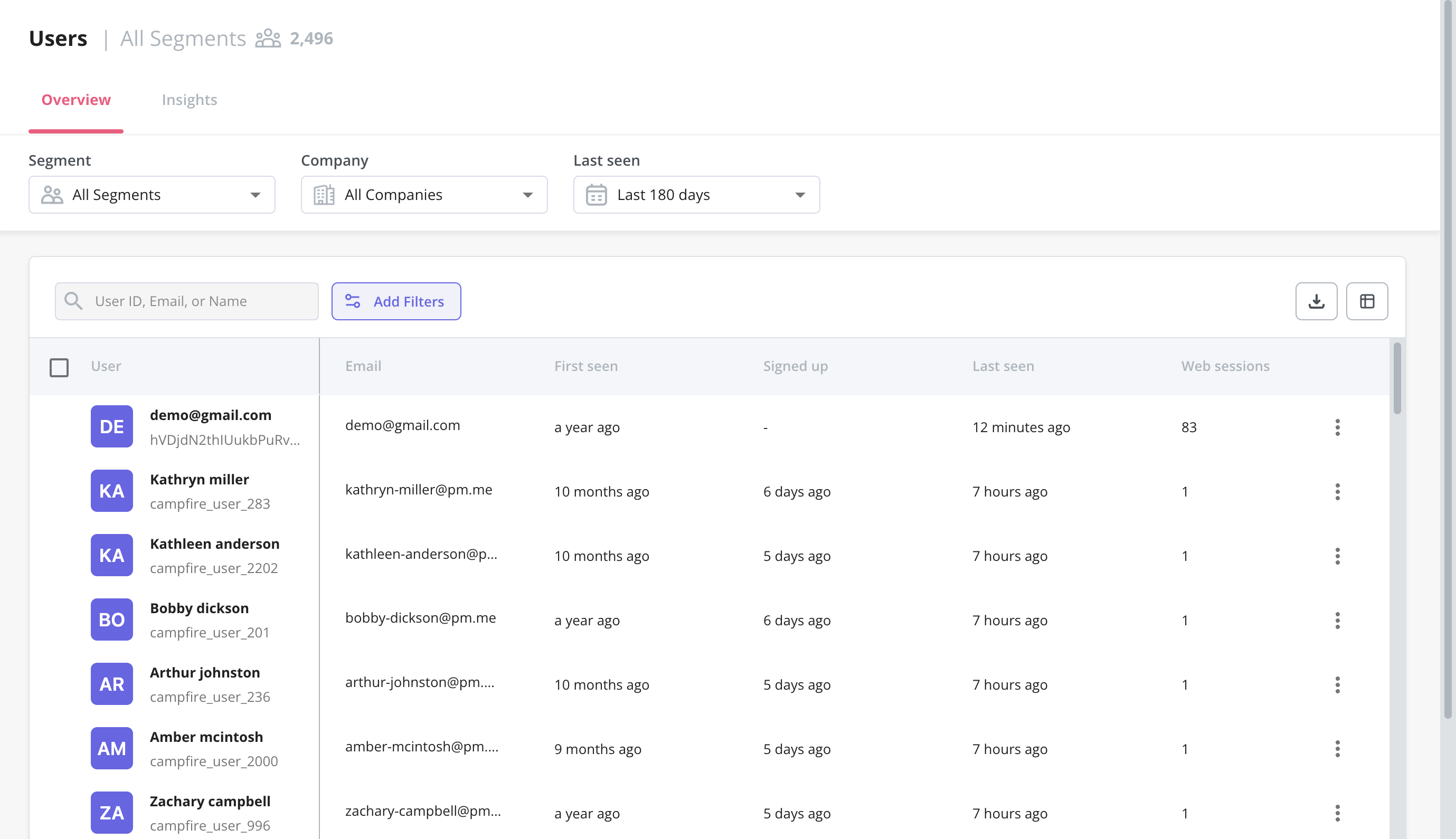
- Trends and funnels: Userpilot’s trends and funnels reports let you track certain events like a specific feature’s usage, add filters to narrow down the data, and then create a breakdown based on segmentation data or user attributes — offering quick and actionable CX reports.

- Satisfaction benchmarking: Userpilot has a built-in NPS dashboard that tracks customer loyalty over time. In addition to the NPS dashboard, you can also use Userpilot’s survey templates to run CSAT or CES surveys and gather additional quantitative and qualitative insights on the customer experience.
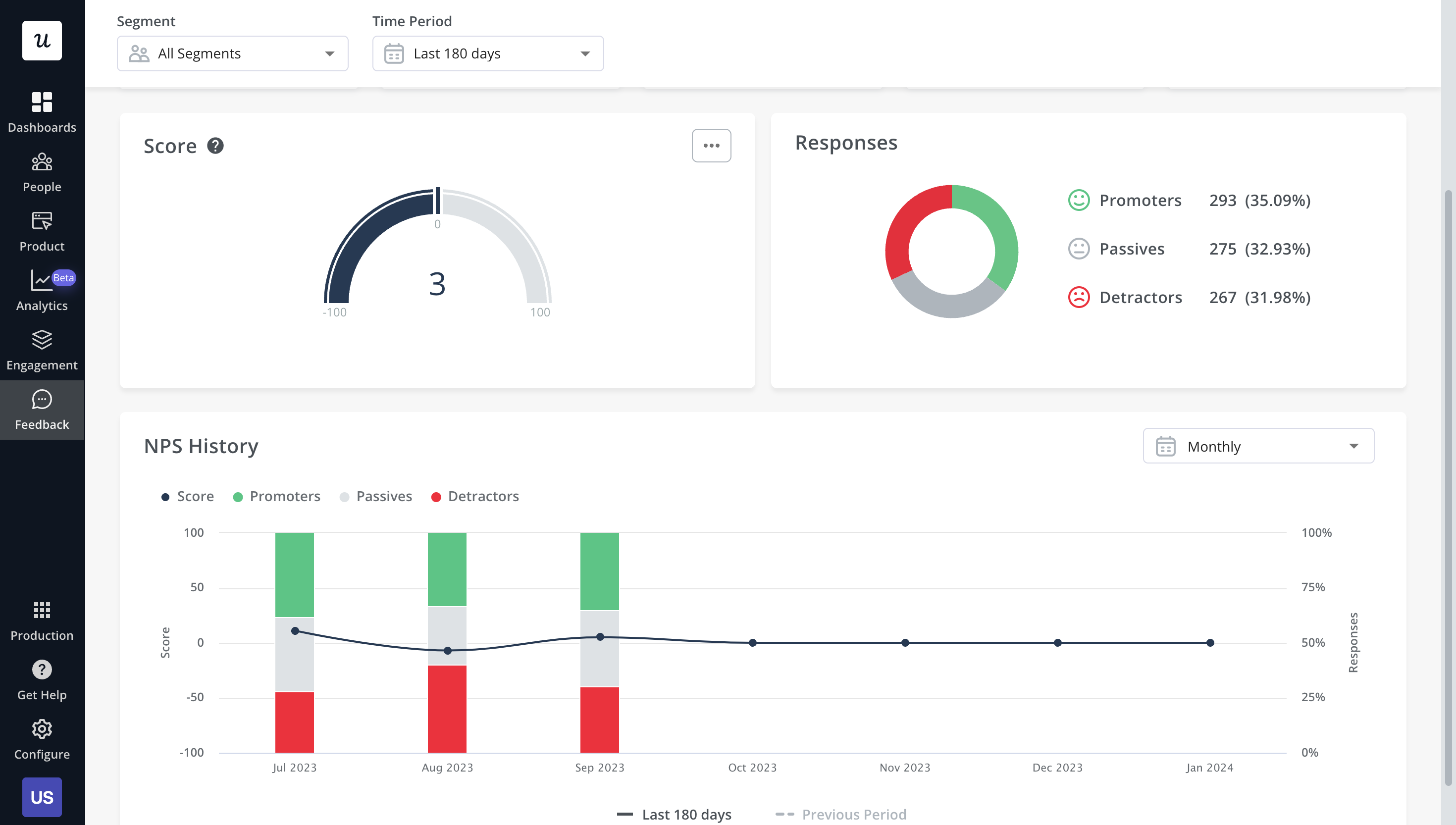
- Self-service support: Userpilot lets you build in-app resource centers, which can include feedback widgets to collect feedback passively, checklists to walk users through specific processes, or integrations with knowledge bases to leverage existing documentation.

- In-app flows: Userpilot’s no-code flow builder helps you create product experiences that can help you optimize the customer experience by educating customers and reducing their time-to-value (TTV). All UI patterns are available on every Userpilot plan from Starter to Enterprise.

Usetiful for customer experience
A frictionless customer experience can be instrumental in improving user retention and loyalty. That, in turn, can boost feature usage and product adoption. If you want to use Usetiful to improve customer experience, here’s what you can do:
- The Tours, Smart Tips, and Checklists features come in handy for creating seamless onboarding flows. For instance, you can use Smart Tips to provide contextual guidance and minimize user friction. It’s a good idea to refine the audience to create a tailored experience.
- Similarly, you can use the Banners feature to create in-app announcements. These are useful for informing users about new features, product updates, and maintenance schedules. Keeping users in the loop about major changes creates a seamless experience.

- The Knowledge Base feature lets you create helpful content for users. You can use it to share information about different features and how to use them. Plus, you can add these articles to the Knowledge Base Portal to make them readily accessible.
- You can use the Assistants widget to add an in-app help center to your product. It lets users browse content on different topics and troubleshoot problems on their own. You can also recommend relevant content to different users, creating a more personalized experience. Keep in mind that this feature is only available in the Premium and Enterprise plans.

- Additionally, you can add NPS surveys to product tours and walkthroughs to find out what users think about your product. It can help you identify loyal users, and analyzing their behavior further will provide you with deeper insight into why some users stick around while others don’t.
Userpilot vs Usetiful for user feedback
In this section of the article, we’re really going to compare Userpilot vs Usetiful in terms of user feedback. That way, we’ll be able to figure out which tool – Userpilot or Usetiful – is the best option depending on your use case.
Userpilot for user feedback
User feedback is an essential part of listening to the Voice of the Customer (VoC) and making product development or marketing decisions that best suit your customer base. Userpilot has a no-code survey builder, 14 templates to choose from, and advanced analytics for extracting insights.
Here are the Userpilot features you can use to collect customer feedback and analyze it:
- Survey builder: Userpilot’s survey builder lets you edit the content, update the widget’s style/placement, and set page-specific or event-specific triggers to ensure that users see the survey at the most contextual moment — all without writing a single line of code. You can also translate surveys into your audience’s native language.

- Survey templates: There are 14 survey templates to choose from with a wide array of different use cases. You can collect qualitative responses on how to improve the user/product experience or quantitative data for customer satisfaction benchmarking such as CSAT and CES scores.
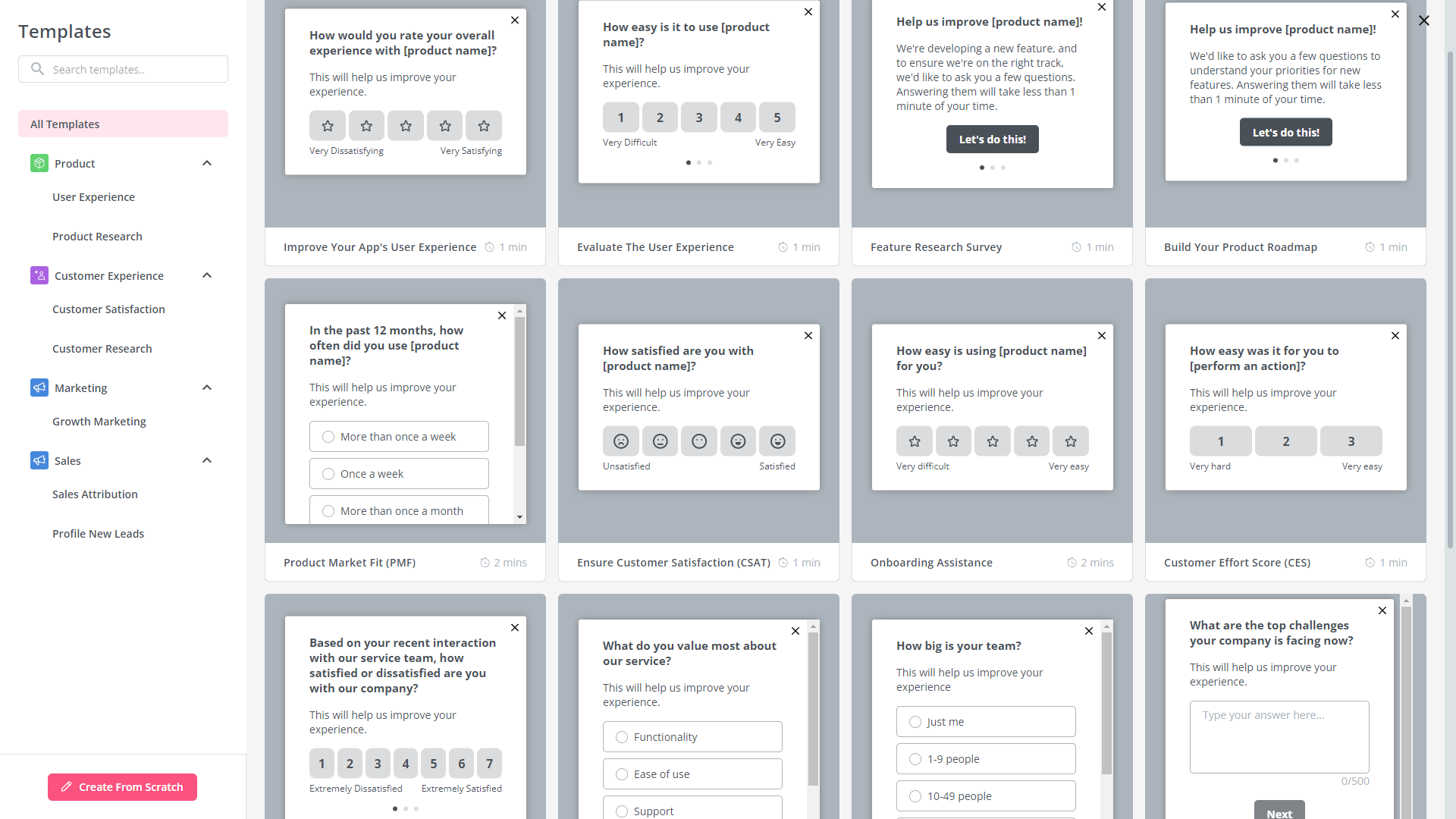
- Advanced analytics: Userpilot’s advanced survey analytics will show you what the most common responses were, what percentage of users selected a specific option, and display open-ended feedback about your product or specific features.
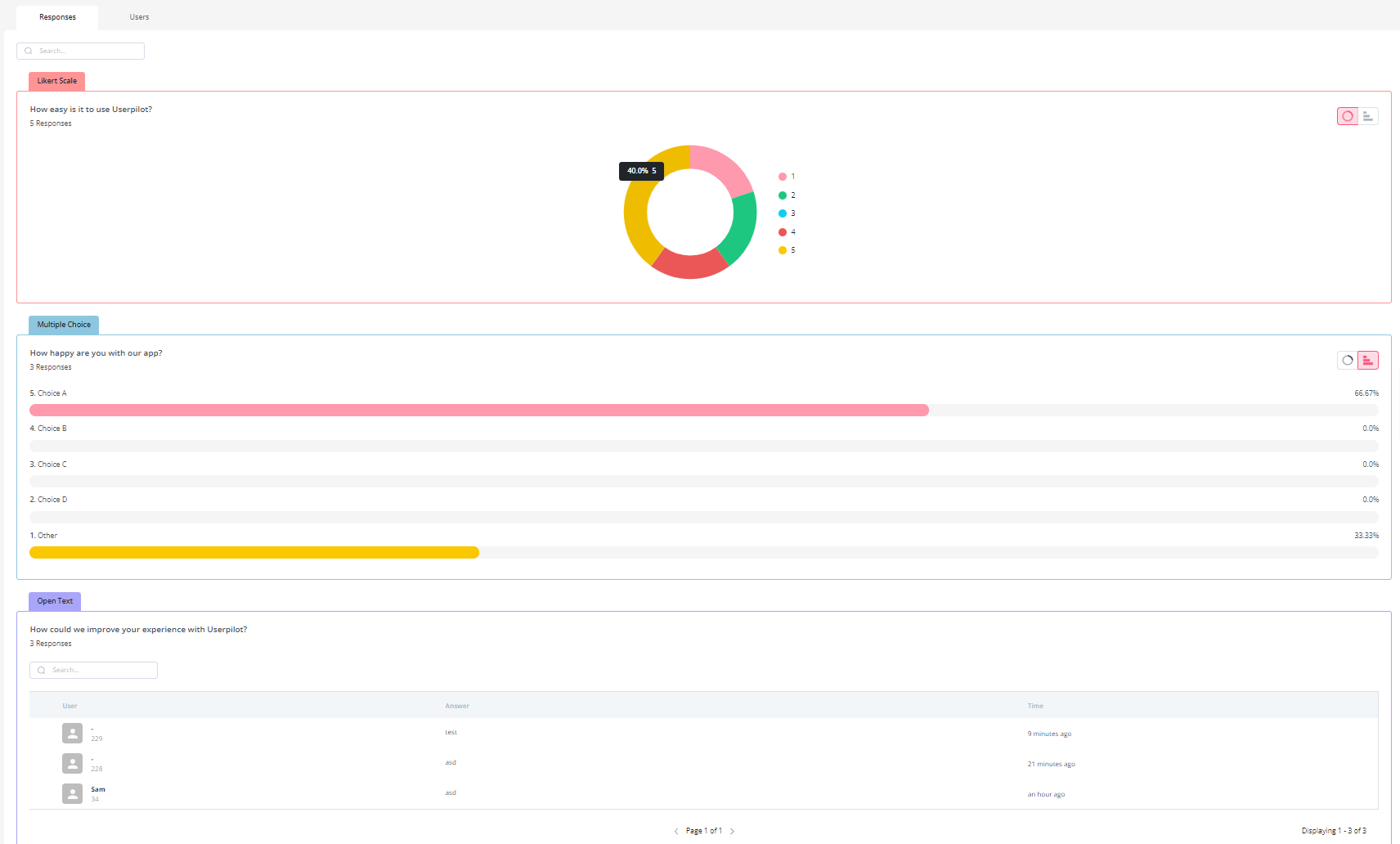
- NPS dashboard: Userpilot’s NPS dashboard compiles response data from all NPS surveys so you don’t have to manually go into each survey and check its analytics. You’ll be able to view key metrics like response rates, total views, and NPS history and sort all the data by different segments.

Usetiful for user feedback
Collecting user feedback is an integral part of improving retention rates and driving conversions. It can also help you understand whether your marketing and product development efforts are headed in the right direction.
With Usetiful, here’s how you can collect user feedback:
- You can create and run a few different types of surveys. These include NPS and reaction-based surveys. While reaction-based responses provide a general idea of user sentiment, NPS scores can help you identify promoters and detractors.

- Keep in mind that Usetiful only allows you to create surveys as a part of product tours. You can add survey questions to any step of a tour, but you can’t create independent surveys. Also, you don’t have the option to design multi-step surveys with branching logic.
- It’s also worth noting that Usetiful only offers basic survey analytics and doesn’t let you trigger personalized in-app flows based on responses.
If you’re looking for a platform that offers a wide variety of survey templates and advanced survey analytics, you should opt for Userpilot.
Userpilot vs Usetiful: Which one you should choose?
To further simplify this selection process, let’s break down the strengths and limitations of each tool. Understanding the distinct advantages and potential drawbacks of Userpilot and Usetiful will provide you with a detailed roadmap for making a well-informed decision!
Pros and cons of Userpilot
Pros of Userpilot
As a full-suite digital adoption platform, Userpilot has all the features you need to onboard users, track analytics, and gather feedback from customers without writing a single line of code. Here are a few pros of using Userpilot as your product growth solution:
- No-code builder: Userpilot’s Chrome extension lets you build flows, add UI elements, and tag features without writing a single line of code.
- UI patterns: There are plenty of UI patterns to choose from when using Userpilot, such as hotspots, tooltips, banners, slideouts, modals, and more!
- Startup-friendly: Userpilot’s entry-level plan gives you access to all available UI patterns so you can hit the ground running.
- Walkthroughs and flows: Build engaging interactive walkthroughs and personalized onboarding flows that target specific segments of your user base.
- Self-service support: Build an in-app resource center to help users solve problems, customize its appearance to align it with your brand, and insert various types of content (videos, flows, or chatbots) to keep your customers satisfied.
- A/B testing: Userpilot’s built-in A/B testing capabilities will help you split-test flows, iterate on the best-performing variants, and continually optimize based on user behavior.
- Feedback collection: Userpilot has built-in NPS surveys with its own unified analytics dashboard and response tagging to help you retarget users. There are other survey types to choose from and you can even create your own custom survey.
- Survey templates: There are 14 survey templates to choose from so you can gather feedback on specific features or run customer satisfaction benchmarking surveys like CSAT and CES.
- Advanced analytics: Userpilot lets you analyze product usage data, monitor engagement on all in-app flows, and use the data to create user segments that are based on behaviors instead of demographics.
- Event tracking: Userpilot’s no-code event tracking lets you tag UI interactions (hovers, clicks, or form fills) and group them into a custom event that reflects feature usage.
- Third-party integrations: Userpilot has built-in integrations with tools like Amplitude, Mixpanel, Kissmetrics, Segment, Heap, HubSpot, Intercom, Google Analytics, and Google Tag Manager so you can share data between all the solutions in your tech stack.
Cons of Userpilot
Of course, no tool is perfect and there are a few cons to consider before choosing Userpilot as your user onboarding or product growth solution:
- Employee onboarding: Currently, Userpilot only supports in-app customer onboarding.
- Mobile apps: Userpilot doesn’t have any mobile compatibility which could make it difficult for developers with cross-platform applications to create a consistent user experience for both versions of their product.
- Freemium plan: There’s no freemium Userpilot plan so those bootstrapping their startup and need sub-$100 solutions should consider more affordable onboarding platforms like UserGuiding or Product Fruits.
Pros and cons of Usetiful
Pros of Usetiful
As with any digital adoption platform, Usetiful offers a wide array of features to simplify user onboarding and boost product adoption. Its benefits include the following:
- Ease of use: Usetiful offers an intuitive and user-friendly interface that’s easy to navigate, even for users from non-technical backgrounds. Most features are accompanied by contextual tooltips, making it easy to get the hang of the platform. The no-code WYSIWYG builder simplifies things further for non-technical teams.
- Hassle-free implementation: Setting up Usetiful for your product is equally straightforward. All you have to do is add a Javascript code to your app. It requires minimal developer support.
- Works on third-party apps: Usetiful doesn’t just work on products you’ve built. You can also use it to create in-app experiences in third-party tools. In other words, it’s suitable for onboarding new users and employees alike.
- Chrome extension: Usetiful comes with a Chrome extension that sits on top of your product. It comes in handy for non-technical users who want to build flawless in-app experiences in a few clicks.
- Affordable pricing: With paid plans starting at €29 per month, Usetiful offers excellent value for money. It’s also one of the few digital adoption platforms with a forever-free plan. That makes it suitable for small teams with a limited budget. Plus, you have ample freedom to take it for a spin before investing in a paid plan.
Cons of Usetiful
Despite its simplicity and affordability, Usetiful isn’t without flaws. As one of the newer digital adoption platforms in the market, it’s prone to performance issues. Other drawbacks include:
- Limited customizability: Customization options on Usetiful are limited to fonts and colors. Advanced customization is only available through CSS classes, which isn’t always feasible for non-technical users. If your product already has an established brand identity, the lack of customization capabilities might leave you disappointed.
- Lack of built-in integrations: Usetiful supports integration with a handful of third-party tools, such as Survio and Tradly, and HubSpot integration is currently in the works. The lack of third-party integrations restricts the platform’s utility for advanced user analytics and segmentation. You can use webhooks to connect to other apps, but it can be cumbersome when you already have an extensive tech stack.
- Doesn’t work for mobile apps: While Usetiful works for your own and third-party tools, you can only use it on web-based apps. The software doesn’t work on mobile devices (or apps).
- Basic analytics: When it comes to user behavior and product analytics, Usetiful leaves a lot to be desired. The analytics feature provides an overview of the number of users who start and complete an in-app experience. But beyond that, you don’t get in-depth insights into how users navigate your product and interact with different on-screen elements (like Userpilot does).
- Limited in-built survey templates: While Usetiful lets you create in-app surveys, your options are restricted to a small selection of survey templates. Also, you can’t analyze survey responses in detail or trigger in-app experiences based on them.
Userpilot vs Usetiful – Why Userpilot might be a better choice?
 Usetiful offers several helpful features, such as product tours, tooltips, onboarding checklists, and banners. However, there are a few areas where Userpilot stands out. These include:
Usetiful offers several helpful features, such as product tours, tooltips, onboarding checklists, and banners. However, there are a few areas where Userpilot stands out. These include:
- Advanced user segmentation: Userpilot lets you segment users based on a wide array of attributes, behavior patterns, demographics, and custom events. You can even group users based on their responses to in-app surveys. Usetiful’s user segmentation parameters pale in comparison.
- In-depth user analytics: With Userpilot, you get a detailed glimpse into how users move through your app, interact with on-page elements, and use different features. These insights play a crucial role in improving product adoption and user retention. On the other hand, Usetiful only offers basic analytics, such as how many users started and completed an in-app experience.
- More survey options: Userpilot lets you choose from a broad spectrum of built-in survey templates, including NPS, CSAT, CES, and microsurveys. You can even build surveys from scratch and use advanced branching logic to tailor the flow of questions according to a user’s response. Usetiful lacks such variety in survey options.
- Robust integrations: Unlike Usetiful, Userpilot is compatible with a wide range of commonly used tools, such as Google Analytics, HubSpot, Amplitude, Heap, and Segment.
- Excellent customization: Userpilot’s built-in customization options are more extensive than Usetiful’s. You can modify the visual appearance, position, and other aspects of various UI patterns without getting caught up in the complexities of CSS.
Conclusion
Hopefully, this post helped you decide whether Userpilot or Usetiful is more appropriate for your company. As you can see – both have many upsides and downsides.
However, Userpilot provides a better value for money and is a better choice for a mid-market SaaS, especially when it comes to user onboarding and user feedback.
If you’re interested in finding more, book a demo with our team here!
![]()
Try Userpilot – The Best User Onboarding Solution for SaaS


